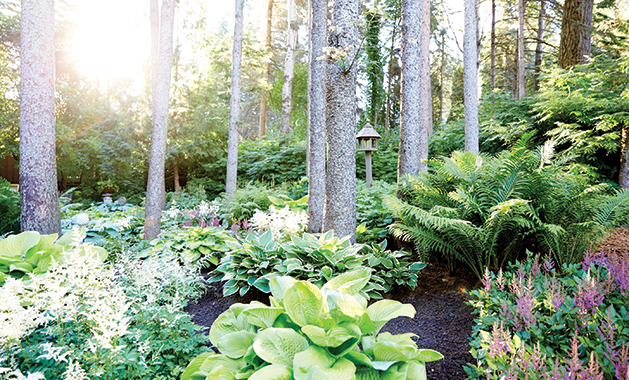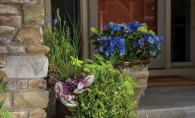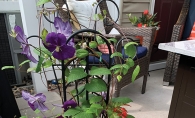
Jan and Karen Hunt have lived in Woodbury’s Evergreen neighborhood for more than 30 years. Known for dense and mature spruce, pine and tamarack trees, these homeowners transformed their once rustic lot into a manicured shade garden that continues to bring them joy.
“This neighborhood was a tree farm initially, and they decided to convert it into a development,” says Jan Hunt. “When we first purchased the lot, it was full of trees. Some were dead. Over a period of time we thinned out the trees and brush. It wasn’t developed at all.”
The Hunts were inspired by a neighbor who was an avid gardener at the time. “I like an orderly, neat woodland look,” says Karen Hunt. “When I saw her garden, I just thought I would love to do something like that in our yard. She was dividing plants and asked me if I was interested in having some. I told her, ‘I want my yard to look like yours by the end of the week,’ and she said, ‘Karen, that is not going to happen. You have to enjoy it and let it evolve.’ She still teases me about that once in a while.”
Following the gift of plants from their neighbor, as well as some advice from a designer friend to unify groupings of pine trees, the Hunts made their first-ever attempt at planting a garden, and they did so without any professional assistance. They began planting beds of hostas and ferns among select trees and defined some mulched pathways between planting beds, continually adding new plants. “It’s been a progression over 25 years,” Karen says. “Everything is perennials, so it comes up every summer. I plant a few annuals here and there.”
Today the shade gardens consist of two small and four large beds throughout the backyard with hundreds of perennials. “With a shade garden, you have to rely on the coloration of the leaves for your interest because there aren’t a lot of flowering things that will last long,” Karen says. “We have bleeding hearts and we love when those bloom, and we have yellow ladyslippers. But more often than not, you’re relying on the edging of hostas or the shape of the leaves.”
The couple admits they learned as they went. “I was the type to plant pots or an urn here and there, but I’d never tackled anything like this,” Karen says. “Now, I keep a garden folder and I love looking in books for ideas, but at that time I would just run to Gertens, see a hosta I liked, and try it. We learned that planting in groups of threes, or odd numbers, will give you a neat, cohesive look.”
Over the years they added a rock creek bed, seating areas, and some other ornamental garden art throughout the property. They counted 127 hostas last year as well as a variety of ferns. “It’s amazing how many plants are suitable for shade,” Karen says.
The garden includes other shade-loving plants such as Annabelle hydrangeas, astilbe, lungwort and groundcover such as wild ginger and pachysandra. They also had luck with shade-loving ash leaf spirea for privacy in a shrub line.
“In a way you never say I’m done with the garden; it’s an ongoing process,” Karen says. “We have to divide hostas this year; they get huge. Dividing allows you to take them into another bed. I share them with my daughter, or with my neighbor. I helped her with a garden last year. I’ve been accused of being obsessed with my yard.”
“That’s what makes it fun; it’s constantly changing and evolving,” Jan says.
Karen and Jan work the garden together with a division of labor that serves them well after 48 years of marriage. “I take care of the garden, and he takes care of what he calls the grunt work, like the lawn mowing, the edging and trimming,” says Karen, who also creates moss-lined flower boxes each season. Jan also has lots of work during the spring and fall clean-up as well as managing slugs that like to eat hostas.
“I feel so good when I’m out there. It’s very therapeutic. I can work out there for eight hours straight,” Karen says.
“I support her too, but I get hungry from time to time,” jokes Jan.
“I really thought [Jan] liked gardening because he’s very proud of it and gives me so much credit,” Karen says. “And he’s out there a quite a bit too. Last year he said ‘I really don’t like gardening.’ I said, ‘Well, why do you do it?’ He said, ‘I do it because I know you love it,’” she says with a laugh. “He had me fooled for many years.”
“I really do love it out there,” Jan says. “We eat just about every meal outside. I read my morning paper and have my breakfast outside.”
“It’s such a tranquil, peaceful area back there when everything is growing,” Karen says. “We do get lots of birds such as cardinals, chickadees, hatches and even turkeys.”
Just as the Hunts were originally inspired by their neighbors, they have paid it forward and enjoy helping their neighbors and friends begin their own gardens. “After this long, I do get a lot of people asking me questions, once they see the yard. It is nice to feel you’re creative enough in that field to help, and I really like to answer questions for people and let them look at the garden if that would help them,” Karen says. “It makes us feel really good that people think it’s nice and that they care to look at it.”









